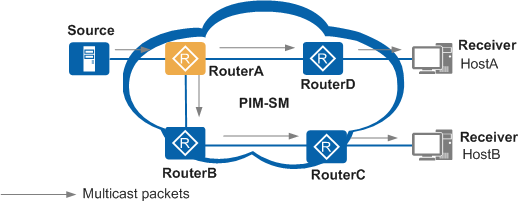PIM GR
Graceful restart (GR) is a high availability (HA) technology that ensures nonstop forwarding during a protocol restart. PIM GR is a multicast protocol GR technology that ensures normal multicast forwarding during an active/standby switchover on a switch with two main control units.
Currently, PIM GR applies only to PIM-SM (ASM model) and PIM-SM (SSM model), and is not supported by PIM-DM.
Implementation
PIM GR depends on GR of a unicast routing protocol. During an active/standby switchover, the PIM protocol on the new active control unit needs to learn join states from downstream neighbors and learn group memberships from IGMP hosts. It does so with the following operations:
Recalculate PIM multicast routing entries.
Maintain the join state of downstream neighbors.
Update multicast routing entries of the forwarding plane.
PIM GR enables a device to quickly restore PIM routing entries on the new active main control unit and update multicast forwarding entries on interface cards quickly after an active/standby switchover. This function minimizes the impact of the active/standby switchover on multicast traffic forwarding.
Working Process
Figure 1 shows the PIM GR process on RouterA.
PIM GR depends on GR of a unicast routing protocol. A PIM GR process involves three phases: GR_START, GR_SYNC, and GR_END.
GR_START
After an active/standby switchover occurs on RouterA, the PIM protocol starts the GR timer, and PIM GR enters the GR_START phase. Unicast GR begins at the same time.
The PIM protocol sends Hello messages carrying a new Generation ID to all interfaces enabled with PIM-SM.
When RouterB and RouterD, reverse path forwarding (RPF) neighbors of RouterA, discover that the Generation ID of RouterA has changed, they send new Join/Prune messages to RouterA.
If dynamic RPs are used, and the neighbors that receive Hello messages with the new Generation ID send a BSR message to RouterA to restore BSR information and RP information on RouterA.
After RouterA receives a Join/Prune message from RouterD or RouterB, it creates a PIM routing entry in an empty inbound interface table to record the Join status of RouterD or RouterB.
During this period, entries in the forwarding table remain unchanged and forwarding of multicast traffic continues.
GR_SYNC
After unicast GR is complete, PIM GR enters the GR_SYNC phase. The PIM protocol builds a multicast distribution tree (MDT) based on unicast routing information, restores the inbound interface of the PIM routing entry, and updates the Join queue to the source or the RP. The PIM protocol then instructs the multicast forwarding module to update the forwarding table.
GR_END
After the GR timer expires, the PIM protocol enters the GR_END phase and notifies the multicast forwarding module. The multicast forwarding module then ages the forwarding entries that were not updated during GR.
